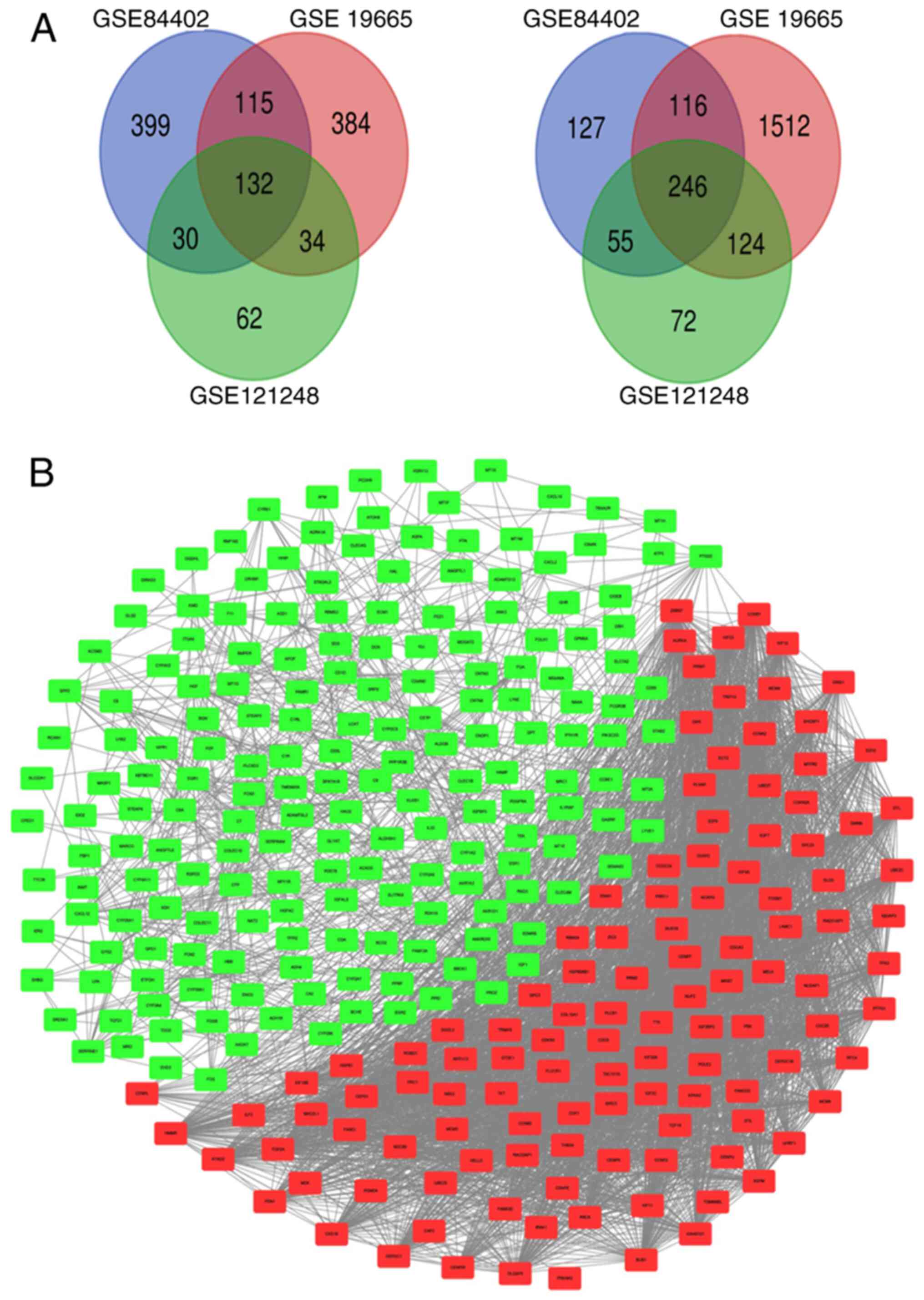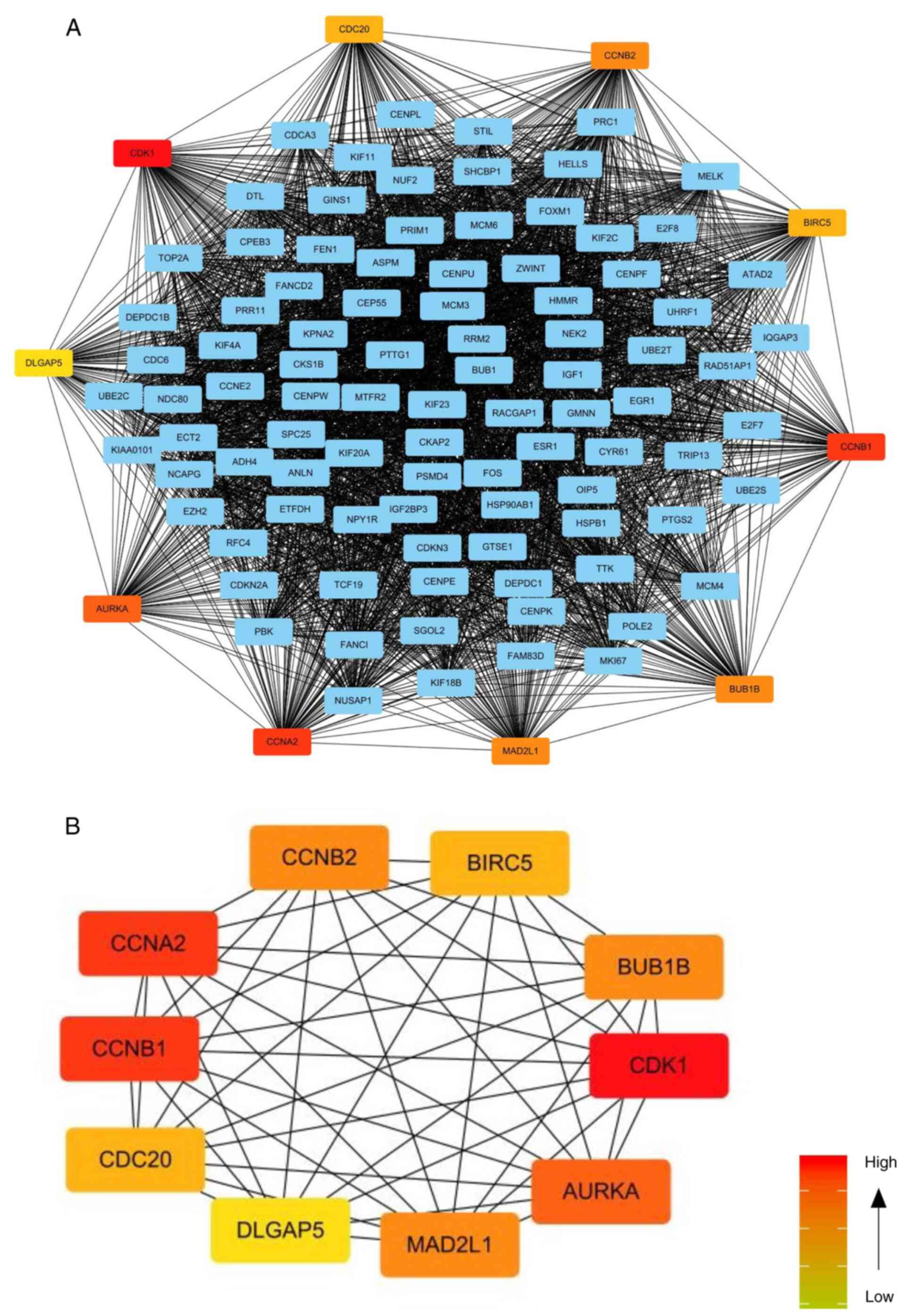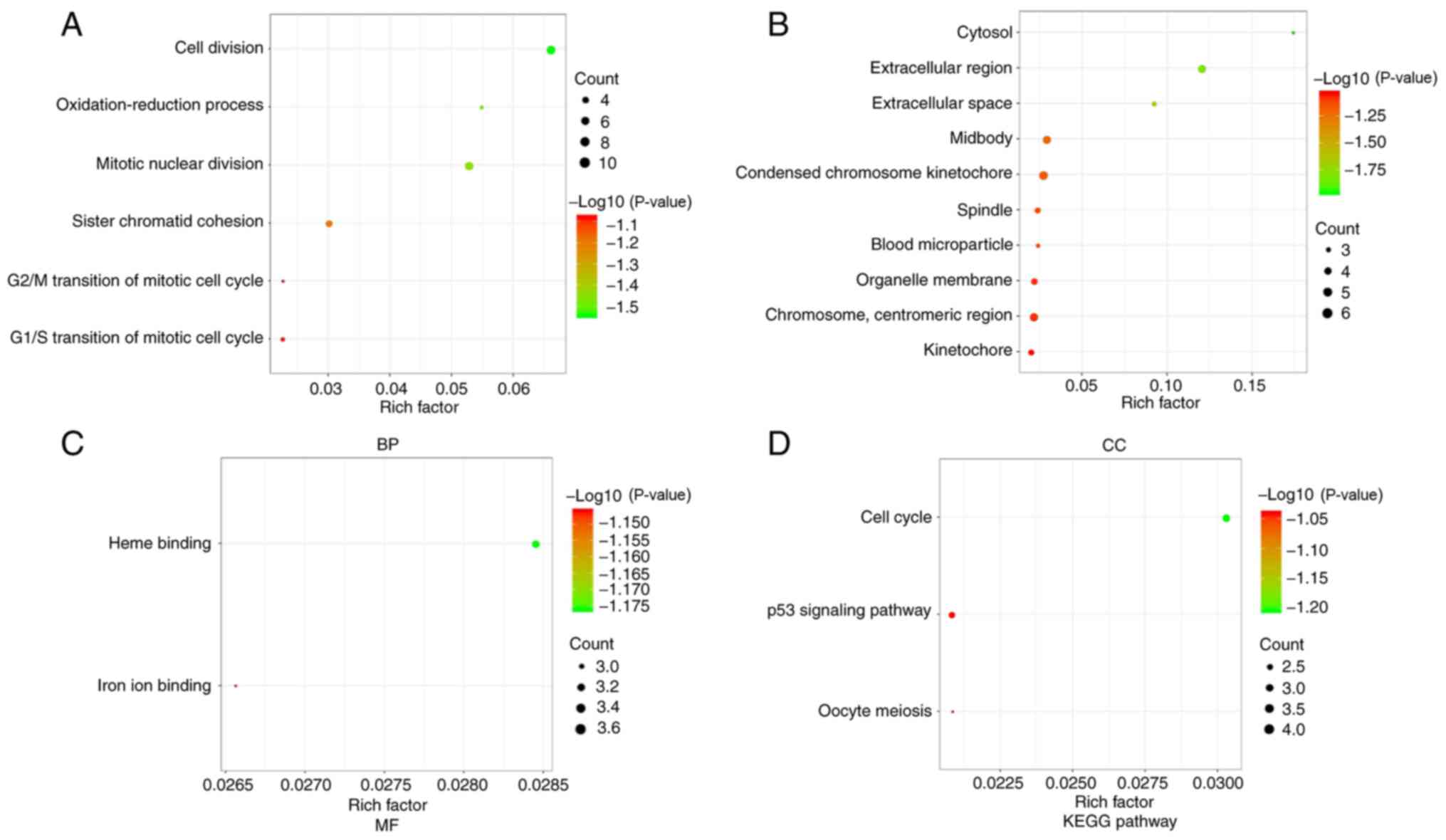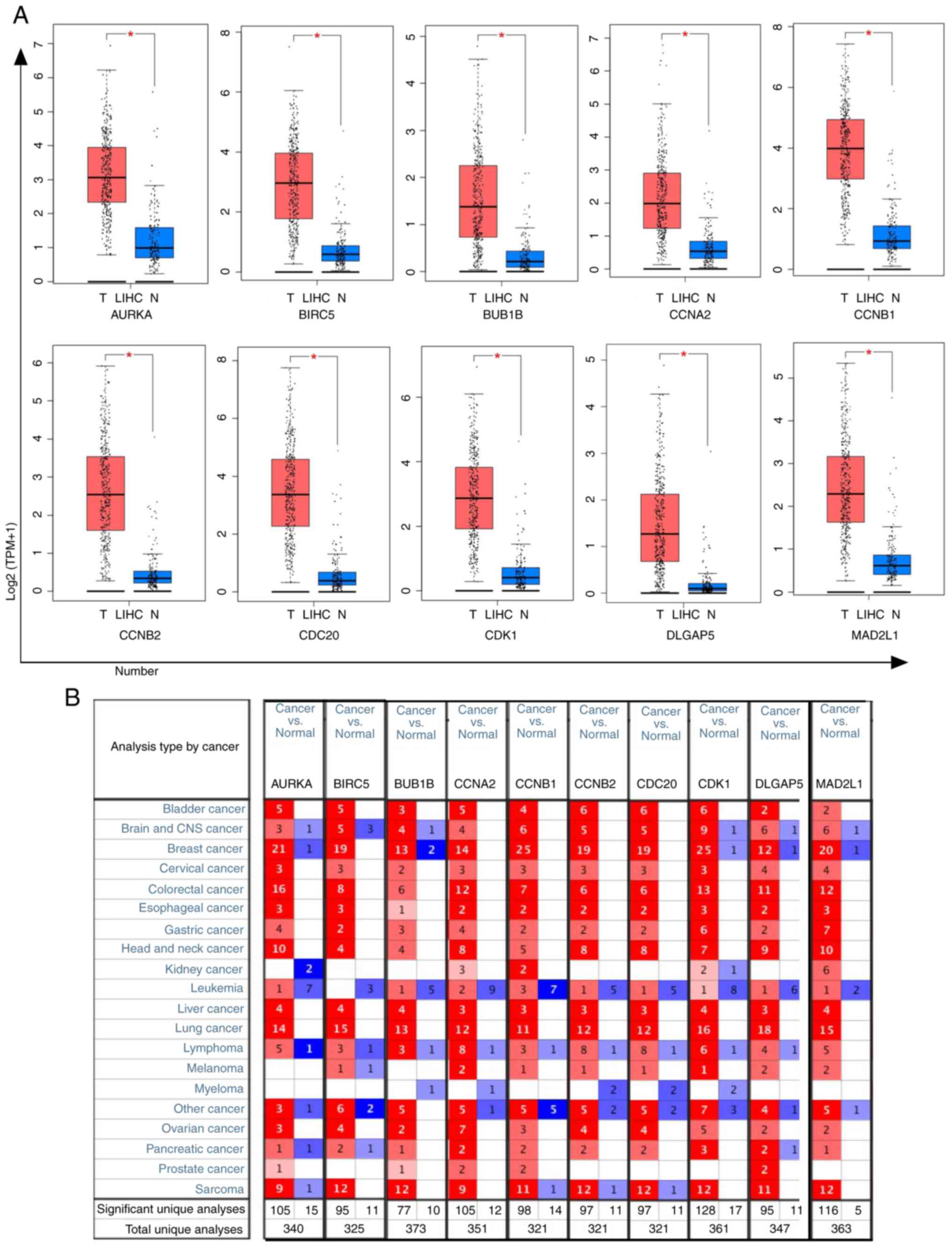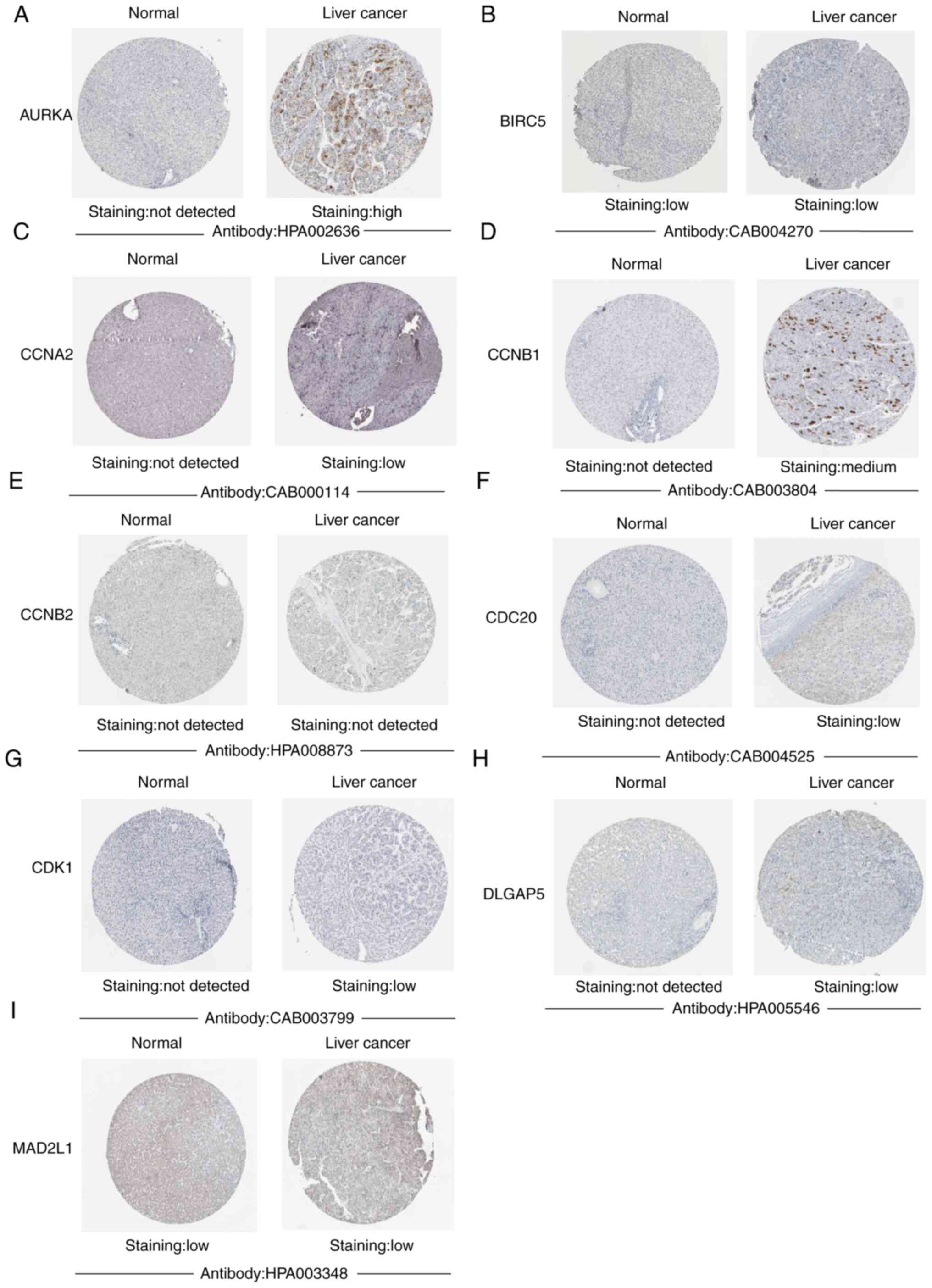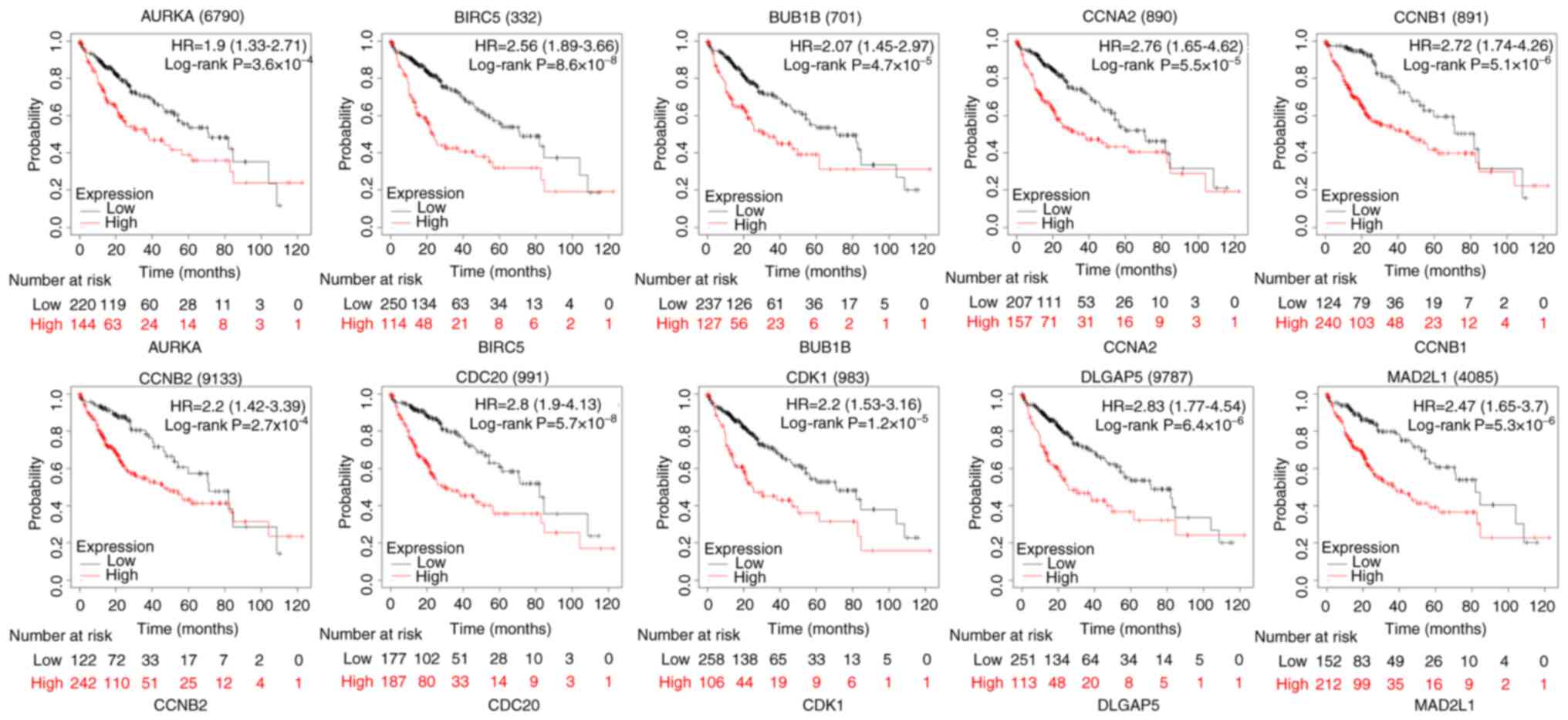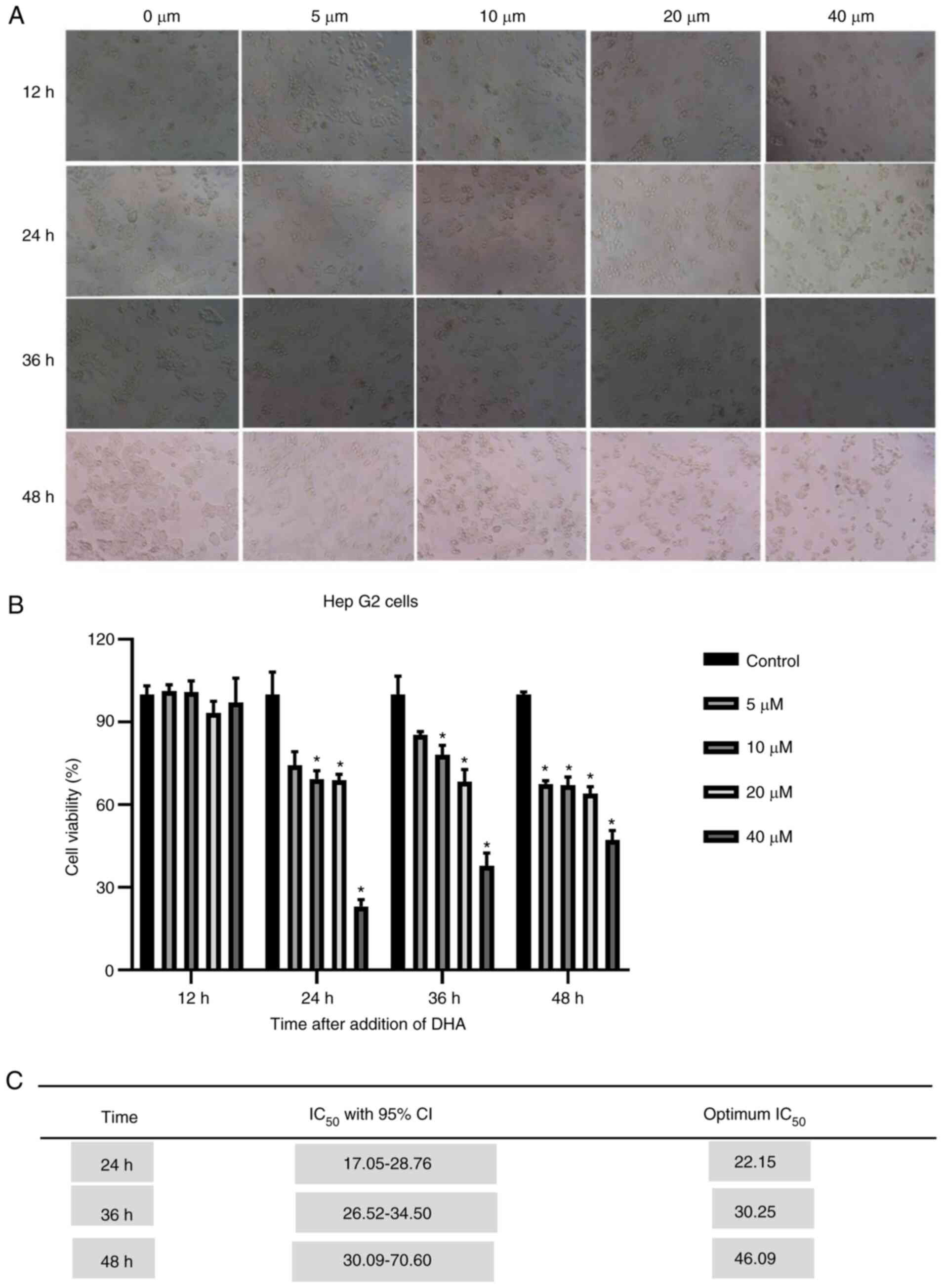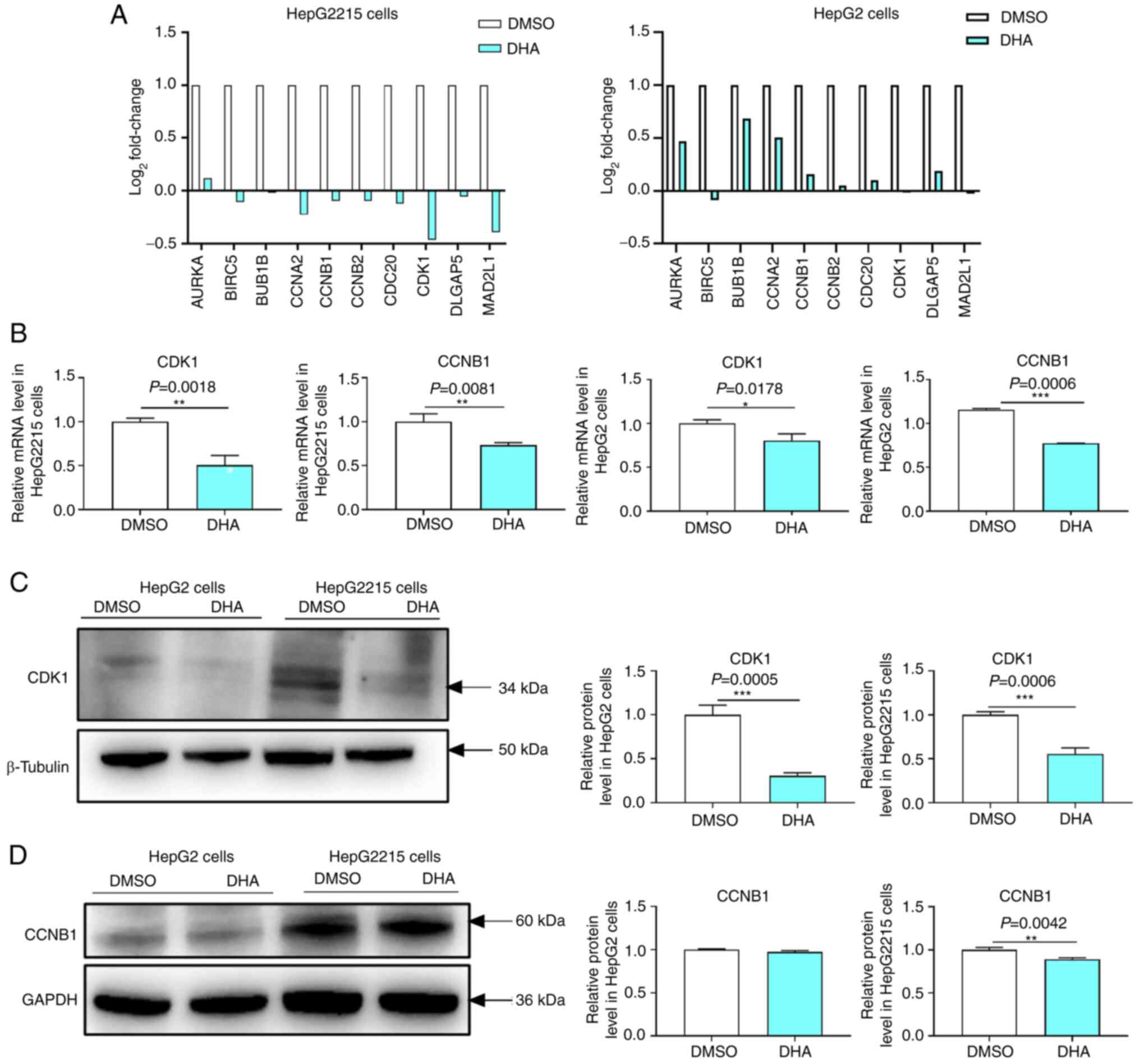|
1
|
Bray F, Ferlay J, Soerjomataram I, Siegel
RL, Torre LA and Jemal A: Global cancer statistics 2018: GLOBOCAN
estimates of incidence and mortality worldwide for 36 cancers in
185 countries. CA Cancer J Clin. 68:394–424. 2018. View Article : Google Scholar : PubMed/NCBI
|
|
2
|
Anwanwan D, Singh SK, Singh S, Saikam V
and Singh R: Challenges in liver cancer and possible treatment
approaches. Biochim Biophys Acta Rev Cancer. 1:1883142020.
View Article : Google Scholar : PubMed/NCBI
|
|
3
|
Zhu HZ, Zhou WJ, Wan YF, Ge K, Lu J and
Jia CK: Downregulation of orosomucoid 2 acts as a prognostic factor
associated with cancer-promoting pathways in liver cancer. World J
Gastroenterol. 26:804–817. 2020. View Article : Google Scholar : PubMed/NCBI
|
|
4
|
Liu CY, Chen KF and Chen PJ: Treatment of
Liver Cancer. Cold Spring Harb Perspect Med. 5:a0215352015.
View Article : Google Scholar : PubMed/NCBI
|
|
5
|
Su S and Huang XW: Advances in the study
of cellular immunotherapy for liver cancer. Zhonghua Gan Zang Bing
Za Zhi. 28:461–465. 2020.(In Chinese). PubMed/NCBI
|
|
6
|
Wang H, Lu Z and Zhao X: Tumorigenesis,
diagnosis, and therapeutic potential of exosomes in liver cancer. J
Hematol Oncol. 12:1332019. View Article : Google Scholar : PubMed/NCBI
|
|
7
|
Zhuang L, Yang Z and Meng Z: Upregulation
of BUB1B, CCNB1, CDC7, CDC20, and MCM3 in tumor tissues predicted
worse overall survival and disease-free survival in hepatocellular
carcinoma patients. Biomed Res Int. 30:78973462018.
|
|
8
|
Song X, Du R, Gui H, Zhou M, Zhong W, Mao
C and Ma J: Identification of potential hub genes related to the
progression and prognosis of hepatocellular carcinoma through
integrated bioinformatics analysis. Oncol Rep. 43:133–146.
2020.PubMed/NCBI
|
|
9
|
Huang Y, Sramkoski RM and Jacobberger JW:
The kinetics of G2 and M transitions regulated by B cyclins. PLoS
One. 8:e808612013. View Article : Google Scholar : PubMed/NCBI
|
|
10
|
Zou Y, Ruan S, Jin L, Chen Z, Han H, Zhang
Y, Jian Z, Lin Y, Shi N and Jin H: CDK1, CCNB1, and CCNB2 are
prognostic biomarkers and correlated with immune infiltration in
hepatocellular carcinoma. Med Sci Monit. 31:9252892020.
|
|
11
|
Liu Y, Gao S, Zhu J, Zheng Y, Zhang H and
Sun H: Dihydroartemisinin induces apoptosis and inhibits
proliferation, migration, and invasion in epithelial ovarian cancer
via inhibition of the hedgehog signaling pathway. Cancer Med.
7:5704–5715. 2018. View Article : Google Scholar : PubMed/NCBI
|
|
12
|
Shi X, Wang L, Ren L, Li J, Li S and Cui
Q: Dihydroartemisinin, an antimalarial drug, induces absent in
melanoma 2 inflammasome activation and autophagy in human
hepatocellular carcinoma HepG2215 cells. Phytother Res.
33:1413–1425. 2019. View
Article : Google Scholar : PubMed/NCBI
|
|
13
|
Ouyang G, Yi B, Pan G and Chen X: A robust
twelve-gene signature for prognosis prediction of hepatocellular
carcinoma. Cancer Cell Int. 20:020–01294. 2020. View Article : Google Scholar
|
|
14
|
Yue C, Ren Y, Ge H, Liang C, Xu Y, Li G
and Wu J: Comprehensive analysis of potential prognostic genes for
the construction of a competing endogenous RNA regulatory network
in hepatocellular carcinoma. Onco Targets Ther. 12:561–576. 2019.
View Article : Google Scholar : PubMed/NCBI
|
|
15
|
Wang L, Sun T, Li S, Zhang Z, Jia J and
Shan B: Protein anabolism is key to long-term survival in
high-grade serous ovarian cancer. Transl Oncol. 14:92021.
|
|
16
|
Chen B, Sun D, Qin X and Gao XH: Screening
and identification of potential biomarkers and therapeutic drugs in
melanoma via integrated bioinformatics analysis. Invest New Drugs.
Jan 26–2021.(Epub ahead of print). View Article : Google Scholar
|
|
17
|
Zhan Z, Chen Y, Duan Y, Li L, Mew K, Hu P,
Ren H and Peng M: Identification of key genes, pathways and
potential therapeutic agents for liver fibrosis using an integrated
bioinformatics analysis. PeerJ. 22:e66452019. View Article : Google Scholar
|
|
18
|
Cai X, Ye T, Liu C, Lu W, Lu M, Zhang J,
Wang M and Cao P: Luteolin induced G2 phase cell cycle arrest and
apoptosis on non-small cell lung cancer cells. Toxicol In Vitro.
25:1385–1391. 2011. View Article : Google Scholar : PubMed/NCBI
|
|
19
|
Mishra RK, Mishra V, Pandey A, Tiwari AK,
Pandey H, Sharma S, Pandey AC and Dikshit A: Exploration of
anti-Malassezia potential of Nyctanthes arbor-tristis L. and their
application to combat the infection caused by Mala s1 a novel
allergen. BMC Complement Altern Med. 16:1142016. View Article : Google Scholar : PubMed/NCBI
|
|
20
|
Lin W, Jia G, Sun H, Sun T and Hou D:
Genome sequence of the fungus Pycnoporus sanguineus, which produces
cinnabarinic acid and pH- and thermo-stable laccases. Gene.
742:132020. View Article : Google Scholar
|
|
21
|
Livak KJ and Schmittgen TD: Analysis of
relative gene expression data using real-time quantitative PCR and
the 2(-Delta Delta C(T)) method. Methods. 25:402–408. 2001.
View Article : Google Scholar : PubMed/NCBI
|
|
22
|
Fang L, Du WW, Awan FM, Dong J and Yang
BB: The circular RNA circ-Ccnb1 dissociates Ccnb1/Cdk1 complex
suppressing cell invasion and tumorigenesis. Cancer Lett.
459:216–226. 2019. View Article : Google Scholar : PubMed/NCBI
|
|
23
|
Alfonso-Pérez T, Hayward D, Holder J,
Gruneberg U and Barr FA: MAD1-dependent recruitment of CDK1-CCNB1
to kinetochores promotes spindle checkpoint signaling. J Cell Biol.
218:1108–1117. 2019. View Article : Google Scholar
|
|
24
|
Gavet O and Pines J: Progressive
activation of CyclinB1-Cdk1 coordinates entry to mitosis. Dev Cell.
18:533–543. 2010. View Article : Google Scholar : PubMed/NCBI
|
|
25
|
Wu CX, Wang XQ, Chok SH, Man K, Tsang SHY,
Chan ACY, Ma KW, Xia W and Cheung TT: Blocking CDK1/PDK1/β-Catenin
signaling by CDK1 inhibitor RO3306 increased the efficacy of
sorafenib treatment by targeting cancer stem cells in a preclinical
model of hepatocellular carcinoma. Theranostics. 8:3737–3750. 2018.
View Article : Google Scholar : PubMed/NCBI
|
|
26
|
Yang W, Cho H, Shin HY, Chung JY, Kang ES,
Lee EJ and Kim JH: Accumulation of cytoplasmic Cdk1 is associated
with cancer growth and survival rate in epithelial ovarian cancer.
Oncotarget. 7:49481–49497. 2016. View Article : Google Scholar : PubMed/NCBI
|
|
27
|
Chai N, Xie HH, Yin JP, Sa KD, Guo Y, Wang
M, Liu J, Zhang XF, Zhang X, Yin H, et al: FOXM1 promotes
proliferation in human hepatocellular carcinoma cells by
transcriptional activation of CCNB1. Biochem Biophys Res Commun.
500:924–929. 2018. View Article : Google Scholar : PubMed/NCBI
|
|
28
|
Meng Z, Wu J, Liu X, Zhou W, Ni M, Liu S,
Guo S, Jia S and Zhang J: Identification of potential hub genes
associated with the pathogenesis and prognosis of hepatocellular
carcinoma via integrated bioinformatics analysis. J Int Med Res.
48:3000605209100192020. View Article : Google Scholar : PubMed/NCBI
|
|
29
|
Li Q, Zhang L, Jiang J, Zhang Y, Wang X,
Zhang Q, Wang Y, Liu C and Li F: CDK1 and CCNB1 as potential
diagnostic markers of rhabdomyosarcoma: Validation following
bioinformatics analysis. BMC Med Genomics. 12:1982019. View Article : Google Scholar : PubMed/NCBI
|
|
30
|
Li Y, Chen YL, Xie YT, Zheng LY, Han JY,
Wang H, Tian XX and Fang WG: Association study of germline variants
in CCNB1 and CDK1 with breast cancer susceptibility, progression,
and survival among Chinese Han women. PLoS One. 8:e844892013.
View Article : Google Scholar : PubMed/NCBI
|
|
31
|
Gomathinayagam R, Sowmyalakshmi S,
Mardhatillah F, Kumar R, Akbarsha MA and Damodaran C: Anticancer
mechanism of plumbagin, a natural compound, on non-small cell lung
cancer cells. Anticancer Res. 28:785–792. 2008.PubMed/NCBI
|
|
32
|
Cheong DHJ, Tan DWS, Wong FWS and Tran T:
Anti-malarial drug, artemisinin and its derivatives for the
treatment of respiratory diseases. Pharmacol Res. 158:132020.
View Article : Google Scholar : PubMed/NCBI
|
|
33
|
Lin R, Zhang Z, Chen L, Zhou Y, Zou P,
Feng C, Wang L and Liang G: Dihydroartemisinin (DHA) induces
ferroptosis and causes cell cycle arrest in head and neck carcinoma
cells. Cancer Lett. 381:165–175. 2016. View Article : Google Scholar : PubMed/NCBI
|
|
34
|
Zhang B, Zhang Z, Wang J, Yang B, Zhao Y,
Rao Z and Gao J: Dihydroartemisinin sensitizes Lewis lung carcinoma
cells to carboplatin therapy via p38 mitogen-activated protein
kinase activation. Oncol Lett. 15:7531–7536. 2018.PubMed/NCBI
|
|
35
|
Jin H, Jiang AY, Wang H, Cao Y, Wu Y and
Jiang XF: Dihydroartemisinin and gefitinib synergistically inhibit
NSCLC cell growth and promote apoptosis via the Akt/mTOR/STAT3
pathway. Mol Med Rep. 16:3475–3481. 2017. View Article : Google Scholar : PubMed/NCBI
|
|
36
|
Yao L, Xie H, Jin QY, Hu WL and Chen LJ:
Analyzing anti-cancer action mechanisms of dihydroartemisinin using
gene chip. Zhongguo Zhong Yao Za Zhi. 33:1583–1586. 2008.(In
Chinese). PubMed/NCBI
|
|
37
|
Ji Y, Zhang YC, Pei LB, Shi LL, Yan JL and
Ma XH: Anti-tumor effects of dihydroartemisinin on human
osteosarcoma. Mol Cell Biochem. 351:99–108. 2011. View Article : Google Scholar : PubMed/NCBI
|
|
38
|
Huang FY, Wong DK, Seto WK, Mak LY, Cheung
TT and Yuen MF: Tumor suppressive role of mitochondrial sirtuin 4
in induction of G2/M cell cycle arrest and apoptosis in hepatitis B
virus-related hepatocellular carcinoma. Cell Death Discov.
7:882021. View Article : Google Scholar : PubMed/NCBI
|
|
39
|
Wang Q, Chen Y, Feng H, Zhang B and Wang
H: Prognostic and predictive value of HURP in non-small cell lung
cancer. Oncol Rep. 39:1682–1692. 2018.PubMed/NCBI
|
|
40
|
Ding X, Duan H and Luo H: Identification
of core gene expression signature and key pathways in colorectal
cancer. Front Genet. 11:452020. View Article : Google Scholar : PubMed/NCBI
|















